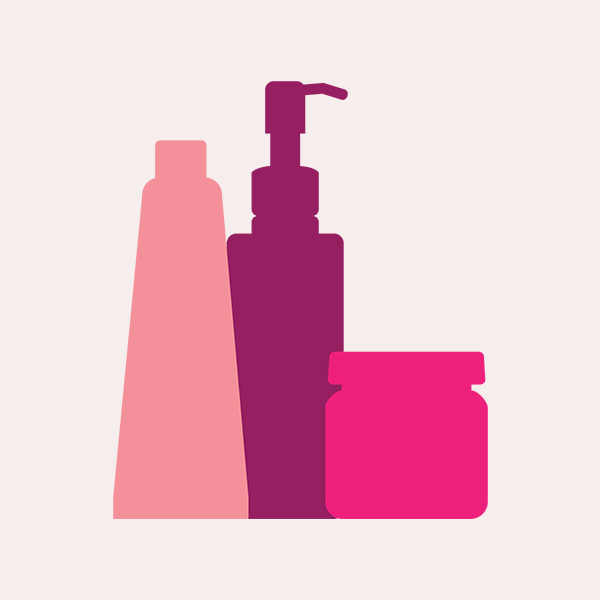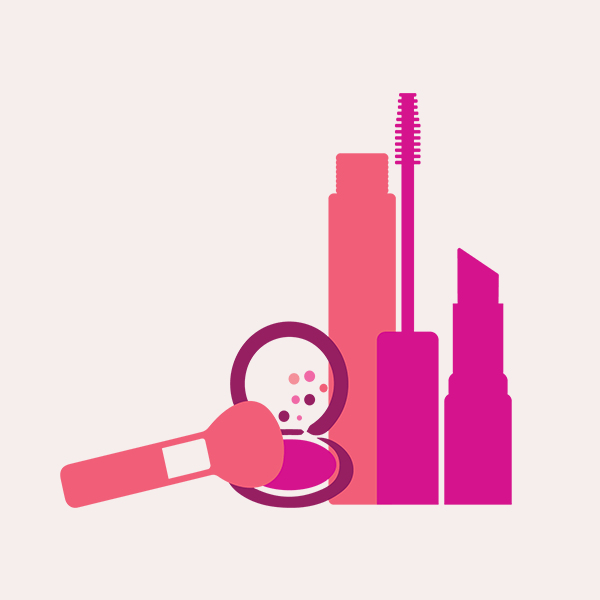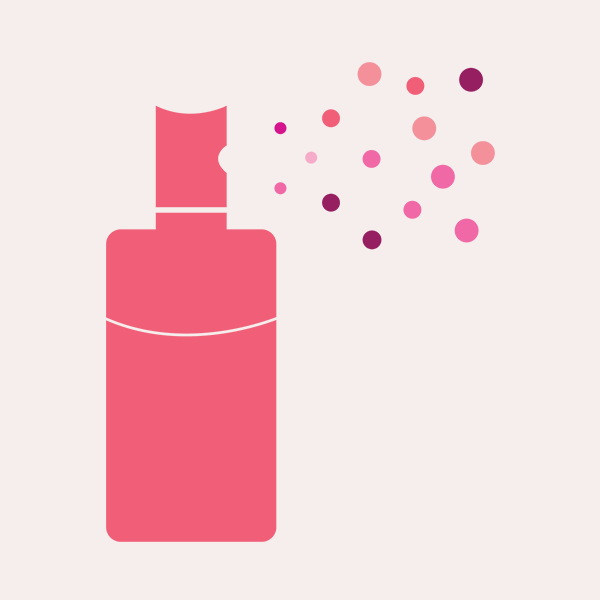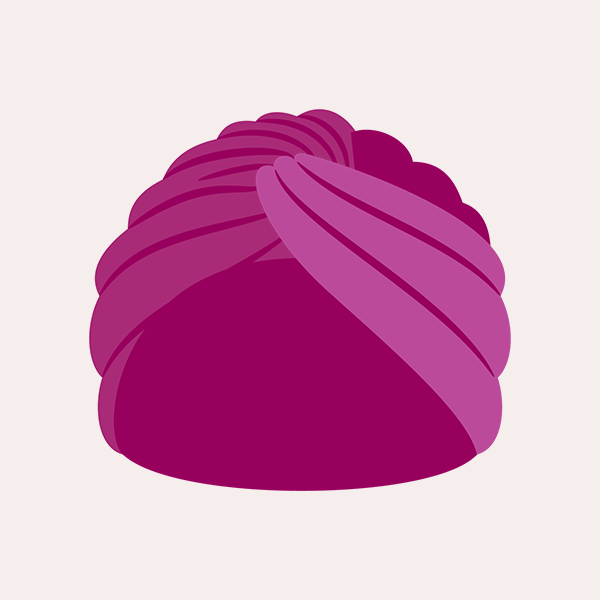
Skin care
Start by soaking two cotton pads with eye make-up remover and place one on each closed eye. Hold them in place for a few seconds, allowing the product to dissolve any eye make-up, then gently wipe away. Using a separate cotton pad on each eye will minimise the spread of bacteria.
Next, cleanse your skin using a gentle, creamy cleanser. Warm a small amount of product between the hands then massage it over your face and neck, avoiding the eye area. Remove it using a gentle swiping motion with a soft, wet towel. A foaming cleanser can be used, but avoid exfoliating products as they may be too harsh for your skin while you are undergoing treatment.
To remove excess residue, apply a mild toner to a cotton pad and gently swipe across the skin from the centre of the face outwards, avoiding the eye area.
Sunscreens either absorb or reflect UV radiation. They do this via ingredients called ‘UV filters’ and there are two main categories of UV filters:
- Organic filters absorb UV radiation – these are sometimes referred to as ‘chemical sunscreens’. These are sunscreens that most of us are used to and absorb UV rays. They must be applied on clean, dry skin before moisturiser.
- Inorganic filters scatter and reflect UV radiation – these are sometimes referred to as ‘physical' or 'mineral sunscreens’. These often use active minerals like zinc oxide and titanium dioxide to reflect UV rays and as their name suggests, provide a physical barrier. They must be applied to the skin after moisturiser.
Sunscreen should be applied during your daily morning routine to help avoid incidental sun damage. Look Good Feel Better follows the recommendations of the Cancer Council Australia in regards to sunscreen use. Look for a broad-spectrum sunscreen with a minimum protection of SPF30.
Massage the sunscreen into your face, neck and ears (avoiding your eyes) 20 minutes before you go outside, and reapply at least every two hours. Apply half a teaspoon of sunscreen to the face, neck, ears and the scalp if you have experienced hair loss, and one teaspoon to each limb, the front of the body and the back of the body.
Always patch test sunscreen, store it in a cool and dry place, and be mindful of its expiry date. Although some products like moisturisers and foundations contain SPFs, you should always use a dedicated sunscreen underneath.
It's important to remember no sunscreen, even if it is reapplied regularly, offers complete protection against UV radiation. Always use sunscreen in conjunction with other forms of sun protection like protective clothing, a hat, and sunglasses, and seek shade when outdoors. A hat that provides shade on the neck is particularly important if hair loss has been experienced as a result of treatment.
All primary sunscreens on the Australian market are subject to rigorous safety checks by the Therapeutic Goods Administration and must additionally meet mandatory quality and performance tests specified by Australian Standards. For more information on this, visit the TGA website https://www.tga.gov.au/products/medicines/sunscreens/how-tga-regulates-sunscreens
Using a moisturiser morning and night will keep the skin hydrated while protecting from environmental damage caused by pollution, sun, wind and everyday living.
Squeeze or scoop a small amount of moisturiser into your hands and warm it up before applying it to the face and neck using soft gentle patting movements, or gentle upward strokes. A special eye cream should be applied around the delicate eye area by gently patting the ring finger around the orbital bone.

Make-up
Colour correctors and concealers are useful tools to help balance obvious colour changes to skin tone. You may have noticed redness, sallowness or spots appearing as a side-effect of treatment. Think about the opposite colours on a colour wheel to determine what colour will correct each issue.
Green correctors will minimise redness in the skin; mauve or blue correctors lift the complexion and add warmth combating sallowness; and yellow correctors help cover pigmentation and dark circles.
Concealers contain light-reflecting particles and are also perfect for camouflaging dark circles under the eyes.
Correctors and concealers can be applied with fingers, a cotton bud or a sponge. Leave the product on the skin for a few seconds allowing it to warm and soften, then gently press it into the skin with the ring finger or a sponge to blend.
Foundation will help even out the complexion and provide a perfect base for other makeup products.
Apply foundation to the T-zone and move the product out towards the hairline and jawline. Liquid foundation can be applied using fingertips, a foundation brush or sponge. Powder foundations can be applied with light, sweeping motions using a large, full brush or the provided sponge.
If using loose powder, the brush should be dipped into a small amount of product and then tapped to ensure any excess falls away. The powder should then be gently buffed in.
It is important that brushes and sponges are kept clean in order to avoid bacterial build-up, and to prevent pressed powder compacts solidifying from coming into contact with any oil left on the sponge or puff.
To set liquid foundation, a finely textured powder in a sheer, natural or translucent shade should be lightly and sparingly applied to the face.
You can brighten the look of your eyes by using complementary eye shadow colours. First, apply a light shade over the entire eyelid. Then to help open up the eyes, apply a darker shade to the outer third of the eyelid – like a basic triangle.
A lighter shade can be applied on the inner corner of the eye to open the eye up and to finish, the colours should be gently blended together so that there are no visible lines.
Using a pencil or liquid eyeliner will help define the lash line and create the illusion of eyelashes that may have been lost through treatment.
If using a pencil, start by rolling it on the back of the hand to warm and soften it before applying to the delicate eye area.
Draw a thin line with short, soft strokes on the upper lid, and then work slowly from the centre of the bottom lid, outwards. You can also draw dots on the lash-line and then blend with a cotton bud, to achieve the desired effect.
Treatment can cause your eyebrows to thin or fall out completely. Eyebrows can be brushed, smudged, or pencilled on to look natural and very flattering. Using short feathery strokes will give the illusion of natural fullness, or an entirely new brow line can be recreated.
- To start, hold a pencil or angled brush (for brow powder) straight up against the dimple of the nose, parallel to the inside corner of the eye. This is where the eyebrow should begin. Draw a small dot to mark the spot.
- To find the arch, place the pencil or brush at the outermost part of your nostril, across the centre of the iris and mark it with another small dot.
- To define the end of the brow, place the pencil or brush diagonally from the outermost part of the nostril, past the outer corner of the eye and draw the final dot.
Now there are three dots marking the basic eyebrow shape, use short, light and feathery strokes to connect them. Make the brow fuller at the beginning and thinner towards the end.
The look of the brow can be softened by running a spoolie brush or a cotton bud lightly through it.
Visit the Video Guides page for a step-by-step video tutorial on how to map your brows.
Your lashes might be thinning but mascara will colour and define any hairs that are present, creating a thicker and fuller look.
Mascara should be applied from root to tip of the top lashes with a slight wiggling movement of the wand to help prevent the mascara from clumping on the lashes.
You can then brush the tip of the wand lightly across the lower lash line, using any remaining product. The mascara wand should never be pumped in and out of the tube, as this pushes air into the tube and will cause the mascara to dry up and thicken. The wand should be gently twisted out of the tube instead.
Mascara should also be replaced at least once every three months to prevent any irritation or infection to the eye. Non-waterproof mascara is kinder to the lashes and easier to remove.
Blush can instantly freshen the face, give a vibrant, healthy look, and define the cheekbones.
Find the apple of your cheeks by smiling into the mirror and placing the brush on the fullest part of the cheek.
Once the apple has been identified, relax the facial muscles and apply powder blush over the apple and gently towards the hairline with light, soft sweeping motions.
Cream blush is great for drier skin and can be applied for a dewy look, but should be used sparingly by softly dabbing it over the apple of the cheeks with the ring or middle finger.
Applying colour to the lips brightens the face and creates balance between the eyes and lower face.
During treatment, your lips may have become dry and/or flaky so a creamy lipstick with moisturising properties in the same colour family as your blush should be used. Lip glosses and lip balms can also help with dryness.
Lip liners define the lip area and help prevent lipstick from bleeding and feathering into the fine lines around the lips. Ensure the tip of your lip liner is nice and rounded before you start to use it.
Apply a coat of lipstick, blot with a tissue, then reapply for a rich and longer lasting colour.

Caring for your products
- Make sure your hands are clean before applying any products.
- Tightly close all jars, tubes, and other make-up containers.
- Scoop products out of containers with clean cotton balls, sponges, or cotton swabs rather than dipping your fingers directly into the product.
- Always check the expiry date on your products and replace them as required. Look for an illustration of a jar with a number inside it on the outer packaging or label of jars, tubes or compacts. This symbol indicates the number of months the product can be used after opening.
- Use clean brushes or disposable applicators to apply powder-based products.
- Do not share your cosmetics or applicators with anyone.
- Always test new make-up products on the back of your hand or wrist first, not your face.

Headwear
Wigs come in a variety of styles and colours and can be made using synthetic or human hair – or a blend of both. These pointers might help to inform your decision when shopping for a wig.
Synthetic hair wigs and blends
Pros: look like human hair; easy to care for; lightweight and comfortable to wear; available in a variety of colours and styles; not as costly as human hair wigs.
Cons: easily damaged by heat and steam, including blow dryers, hair straighteners, curling irons and heat from ovens, barbeques and steam from dishwashers.
Human hair wigs
Pros: feel natural; durable and long-lasting; can be styled using hair dryers, hair straighteners, curling irons, etc.
Cons: can be quite expensive; require more care than synthetic wigs in terms of washing, conditioning and styling.
Partial Wigs
A partial wig is a wig that covers only part of the head. Examples include a medical fringe, halos, stick-on ponytails, hats with hair, and side-fringe hair for hats to cover the hairline.
Both synthetic and human hair options are available and come in different lengths and styles. They are designed to be worn under other headcovers such as hats, scarves and beanies.
For some people, partial wigs can be more comfortable than full wigs as they leave the scalp cool and itch free. They are also generally more affordable than full wigs.
If you have private health insurance, you may be entitled to a reimbursement for the cost of your wig if it is considered a “medical prosthesis”.
Speak to your health fund to determine your eligibility, and for information on how to lodge the claim correctly.
Turbans and scarves
There are hundreds of ways to style your headwear to achieve comfortable, practical and fashionable looks. Turbans can be worn day or night, offering the scalp maximum protection. They can also be used as a base, layered with soft scarves, pins, fringes and other accessories. Experiment with various fabrics like silk, cotton, bamboo or woollen blends and opt for bright and bold colours.
There are a few simple looks you can try below. You can also take a look at our Video Guides and Facebook Tutorials for scarf styling ideas.
Looping & Coiling
Start by folding a large square scarf diagonally so it forms a triangle, and drape the straight edge low over your forehead.
To loop: Bring the ends to the nape of your neck and finish by tying the ends in a loose bow. You can rotate the bow towards either side of your face to change the look.
To coil: Ensure the scarf is longer on one side, then cross the ends over. Twist the longer end until you have created a braid-like strand. Pull it over the top of your head like a headband and tie it firmly in place with the other end at the nape of the neck.
To create a rosette
- Start by folding a large square scarf diagonally so it forms a triangle and drape the straight edge low over your forehead. Tie the ends of the scarf to one side of the face, leaving the ends to drape.
- Tightly twist the ends together to form a braid-like strand, then coil the strand around on itself in a circular motion until a rosette is formed. Tuck any loose ends in.
The T-shirt wrap
The t-shirt wrap looks like a cotton turban with a matching headband around your head. You can either cut straight across a t-shirt from just under the sleeves or use a tubular piece of stretchy fabric.
- Centre the wrap on your forehead at the hairline and over your ears.
- At the back of your head, hold each side of the tube and create a figure eight by crossing the fabric in the right hand over the left.
- With fabric crossed, twist the fabric upward and pull the lower half of the figure eight from the back of your head to the front. This creates a halo or headband effect. Tuck any extra fabric under the twisted band.
Hats
Look for hats made from natural fibres like cotton, linen, wool and silk – or at least make sure the lining is.
Opt for hats with a wide brim and a gusset that sits firmly around the nape of your neck to ensure maximum sun protection.
Some hats are sold with an attached hair piece such as a ponytail, bob or fringe. You can also create your own look by wearing a hat over a wig, scarf or turban.
Make sure the hat you choose fits snuggly and provides total coverage of your hairline.
Visit our Headwear Contacts page for a list of wig and headwear suppliers in your state.
